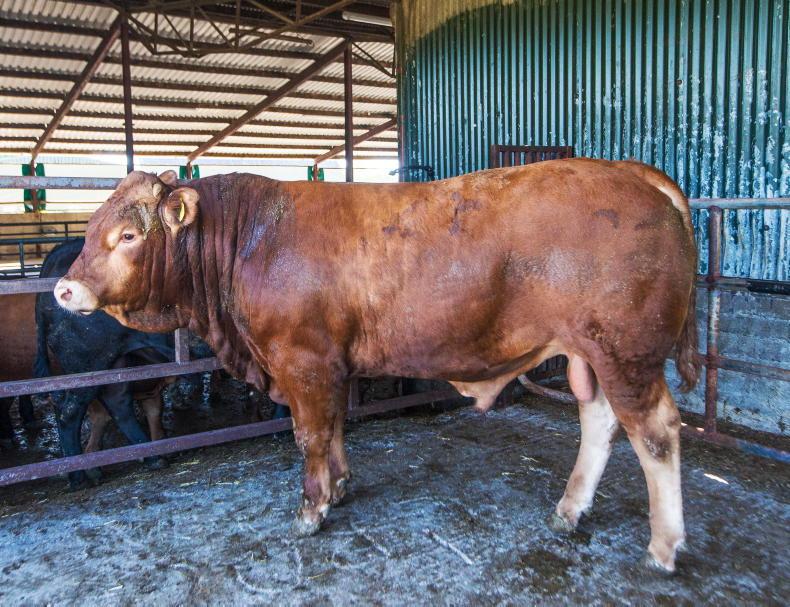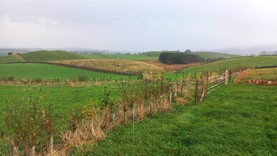The beef sector makes a critical contribution to the agri-food industry and all areas of rural Ireland, with beef and live animal exports growing to €2.5bn in 2021, representing 16% of Irish food and drinks exports.
The growing concern with climate change has led to Irish Government climate targets to achieve a 51% reduction in national greenhouse gas emissions by 2030, including a reduction of between 22% and 30% in agricultural emissions.
One of the ways the beef sector can make a contribution to this reduction target is to reduce slaughter age, with a target in the Climate Action Plan to reduce it by three months.
Finishing beef cattle as bulls rather than steers provides an opportunity to reduce slaughter age by exploiting the greater biological efficiency of bulls.

While bull beef also has the potential to improve farm profitability when compared to steer beef, the systems are more costly and therefore, the risk of price penalties for ‘out-of-spec’ animals and challenges of marketing bulls at farm level when the supply of bulls exceed market demand, have impeded the greater adoption of these systems.
In this article, we outline the most recent bull beef research from Teagasc Grange and farm level considerations for these systems.
Bull beef research at Teagasc Grange
Research at Teagasc Grange has shown that when reared under similar management on the same diet and slaughtered at the same age, carcase weight was 9.5% heavier and lean meat yield was 20% greater for bulls than steers.
The findings from the most recent study, a large, multi-institutional project funded by the Department of Agriculture, Food and the Marine (DAFM), highlighted the potential of bull beef systems to reduce greenhouse gas emissions per kg of beef carcase by up to 32% when compared to steer beef systems, as reported in last week’s edition of the Irish Farmers Journal.
Moreover, this project demonstrated the capacity of bull beef systems to deliver greater profitability than steer beef systems, particularly where spring-born yearling bulls are provided a period at grass.
Following the completion of this large-scale project, Teagasc Grange, in consultation with stakeholders, refocused research on steer beef systems, given the challenges farmers were facing with price and marketing of bulls at the time.
Challenges with bull beef
Until recently, the only age limitation was that bulls had to be slaughtered under 24 months of age to be considered ‘young bull beef’ with no penalties imposed once this criteria was met.
This facilitated a system that turned bulls out to grass for a second grazing season where they could put on a significant amount of liveweight from grass.
A short indoor high meal feeding period was usually then sufficient to make them marketable. This system of bull beef production was very popular among many of the demonstration farms in the Teagasc-Irish Farmers Journal BETTER Farm Beef programme.
While good grazing facilities are important for all grass-based beef systems, this is increasingly so for bull beef systems.
Additionally, vigilance with regard to animal temperament and general health and safety is paramount.
Margins per hectare were almost always higher from these farms compared to those in the programme selling weanlings or finishing steers.
In recent years, carcase specifications for young bull beef have tightened considerably. The 16 month age limit was the biggest change, with a maximum of 400kg carcase weight or less often imposed.
While these specifications are achievable from suckler-bred weanlings, breeding, grassland management and winter feeding have to be top class.
Twenty-five percent of the beef farmer participants in the new Teagasc beef demonstration farm programme, Future Beef, are operating this system of beef production very successfully.
Kildalton Agricultural College has also been demonstrating a very sustainable and profitable under 16 month suckler beef production system to its students and surrounding farmers for a number of years.
Market access
The key requirement with any beef system is market access. Irish beef is marketed internationally as grass-fed steer and heifer beef and these animals tend to have the highest volume demand with lower demand for bull beef.
Therefore, while bull beef tends to track steer beef price, albeit, slightly lower, when the market conditions for beef deteriorate the differential between the steer and bull beef price increases significantly.
Unfortunately, waiting for the market to correct itself is not an option, as the 16 month age limit is more often than not only around the corner for bulls that are fit for slaughter.
The Teagasc advice has always been to discuss with a meat processor their market requirements, and bull beef production should only be considered when there is a forward contract price agreed between the processor and the farmer.
Unfortunately, contracts for bull beef production have been hard to come by in recent years and the number of young bulls slaughtered has fallen (Table 1), with market analysts predicting the young bull kill to drop below 100,000 in 2022.
Bull beef systems:
Provide an opportunity to reduce slaughter age and greenhouse gas emissions by exploiting the inherently greater biological efficiency of bulls.Tend to be more profitable but carry a greater beef price risk than steer beef and are more sensitive to changes in meal price.Are attractive to the most efficient farmers, with many of the participants in demonstration farm programmes operating these systems.Have important carcase and age specifications, which mean farmers should discuss marketing options with processors, ideally contracts, before embarking on this system.Increasing the proportion of males slaughtered as bulls would help to meet climate obligations, however, the implications for farm profitability would be highly precarious without greater market access for these animals in the first instance.
The beef sector makes a critical contribution to the agri-food industry and all areas of rural Ireland, with beef and live animal exports growing to €2.5bn in 2021, representing 16% of Irish food and drinks exports.
The growing concern with climate change has led to Irish Government climate targets to achieve a 51% reduction in national greenhouse gas emissions by 2030, including a reduction of between 22% and 30% in agricultural emissions.
One of the ways the beef sector can make a contribution to this reduction target is to reduce slaughter age, with a target in the Climate Action Plan to reduce it by three months.
Finishing beef cattle as bulls rather than steers provides an opportunity to reduce slaughter age by exploiting the greater biological efficiency of bulls.

While bull beef also has the potential to improve farm profitability when compared to steer beef, the systems are more costly and therefore, the risk of price penalties for ‘out-of-spec’ animals and challenges of marketing bulls at farm level when the supply of bulls exceed market demand, have impeded the greater adoption of these systems.
In this article, we outline the most recent bull beef research from Teagasc Grange and farm level considerations for these systems.
Bull beef research at Teagasc Grange
Research at Teagasc Grange has shown that when reared under similar management on the same diet and slaughtered at the same age, carcase weight was 9.5% heavier and lean meat yield was 20% greater for bulls than steers.
The findings from the most recent study, a large, multi-institutional project funded by the Department of Agriculture, Food and the Marine (DAFM), highlighted the potential of bull beef systems to reduce greenhouse gas emissions per kg of beef carcase by up to 32% when compared to steer beef systems, as reported in last week’s edition of the Irish Farmers Journal.
Moreover, this project demonstrated the capacity of bull beef systems to deliver greater profitability than steer beef systems, particularly where spring-born yearling bulls are provided a period at grass.
Following the completion of this large-scale project, Teagasc Grange, in consultation with stakeholders, refocused research on steer beef systems, given the challenges farmers were facing with price and marketing of bulls at the time.
Challenges with bull beef
Until recently, the only age limitation was that bulls had to be slaughtered under 24 months of age to be considered ‘young bull beef’ with no penalties imposed once this criteria was met.
This facilitated a system that turned bulls out to grass for a second grazing season where they could put on a significant amount of liveweight from grass.
A short indoor high meal feeding period was usually then sufficient to make them marketable. This system of bull beef production was very popular among many of the demonstration farms in the Teagasc-Irish Farmers Journal BETTER Farm Beef programme.
While good grazing facilities are important for all grass-based beef systems, this is increasingly so for bull beef systems.
Additionally, vigilance with regard to animal temperament and general health and safety is paramount.
Margins per hectare were almost always higher from these farms compared to those in the programme selling weanlings or finishing steers.
In recent years, carcase specifications for young bull beef have tightened considerably. The 16 month age limit was the biggest change, with a maximum of 400kg carcase weight or less often imposed.
While these specifications are achievable from suckler-bred weanlings, breeding, grassland management and winter feeding have to be top class.
Twenty-five percent of the beef farmer participants in the new Teagasc beef demonstration farm programme, Future Beef, are operating this system of beef production very successfully.
Kildalton Agricultural College has also been demonstrating a very sustainable and profitable under 16 month suckler beef production system to its students and surrounding farmers for a number of years.
Market access
The key requirement with any beef system is market access. Irish beef is marketed internationally as grass-fed steer and heifer beef and these animals tend to have the highest volume demand with lower demand for bull beef.
Therefore, while bull beef tends to track steer beef price, albeit, slightly lower, when the market conditions for beef deteriorate the differential between the steer and bull beef price increases significantly.
Unfortunately, waiting for the market to correct itself is not an option, as the 16 month age limit is more often than not only around the corner for bulls that are fit for slaughter.
The Teagasc advice has always been to discuss with a meat processor their market requirements, and bull beef production should only be considered when there is a forward contract price agreed between the processor and the farmer.
Unfortunately, contracts for bull beef production have been hard to come by in recent years and the number of young bulls slaughtered has fallen (Table 1), with market analysts predicting the young bull kill to drop below 100,000 in 2022.
Bull beef systems:
Provide an opportunity to reduce slaughter age and greenhouse gas emissions by exploiting the inherently greater biological efficiency of bulls.Tend to be more profitable but carry a greater beef price risk than steer beef and are more sensitive to changes in meal price.Are attractive to the most efficient farmers, with many of the participants in demonstration farm programmes operating these systems.Have important carcase and age specifications, which mean farmers should discuss marketing options with processors, ideally contracts, before embarking on this system.Increasing the proportion of males slaughtered as bulls would help to meet climate obligations, however, the implications for farm profitability would be highly precarious without greater market access for these animals in the first instance. 






 This is a subscriber-only article
This is a subscriber-only article










SHARING OPTIONS: